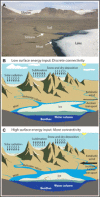The polar regions in a 2°C warmer world
- PMID: 31840060
- PMCID: PMC6892626
- DOI: 10.1126/sciadv.aaw9883
The polar regions in a 2°C warmer world
Abstract
Over the past decade, the Arctic has warmed by 0.75°C, far outpacing the global average, while Antarctic temperatures have remained comparatively stable. As Earth approaches 2°C warming, the Arctic and Antarctic may reach 4°C and 2°C mean annual warming, and 7°C and 3°C winter warming, respectively. Expected consequences of increased Arctic warming include ongoing loss of land and sea ice, threats to wildlife and traditional human livelihoods, increased methane emissions, and extreme weather at lower latitudes. With low biodiversity, Antarctic ecosystems may be vulnerable to state shifts and species invasions. Land ice loss in both regions will contribute substantially to global sea level rise, with up to 3 m rise possible if certain thresholds are crossed. Mitigation efforts can slow or reduce warming, but without them northern high latitude warming may accelerate in the next two to four decades. International cooperation will be crucial to foreseeing and adapting to expected changes.
Copyright © 2019 The Authors, some rights reserved; exclusive licensee American Association for the Advancement of Science. No claim to original U.S. Government Works. Distributed under a Creative Commons Attribution NonCommercial License 4.0 (CC BY-NC).
Figures







References
-
- Overland J. E., Wang M., Walsh J. E., Stroeve J. C., Future arctic climate changes: Adaptation and mitigation time scales. Earths Future 2, 68–74 (2014).
-
- GISTEMPTeam, NASA Goddard Institute for Space Studies (2018); https://science.gsfc.nasa.gov/earth/giss/.
-
- Hansen J., Ruedy R., Sato M., Lo K., Global surface temperature change. Rev. Geophys. 48, 2010RG000345 (2010).
-
- Intergovernmental Panel on Climate Change, Climate Change 2014: Impacts, Adaptation, and Vulnerability, in Contribution of Working Group II to the Fifth Assessment Report of the Intergovernmental Panel on Climate Change, C. B. Field, V. R. Barros, D. J Dokken, K. J. Mach, M. D. Mastrandrea, T. E. Bilir, M. Chatterjee, K. L. Ebi, Y. O. Estrada, R. C. Genova, B. Girma, E. S. Kissel, A. N. Levy, S. MacCracken, P. R. Mastrandrea, L. L. White, Eds. (Cambridge Univ. Press, 2014), pp. 1132.
-
- Ivy D. J., Solomon S., Calvo N., Thompson D. W. J., Observed connections of Arctic stratospheric ozone extremes to Northern Hemisphere surface climate. Environ. Res. Lett. 12, 024004 (2017).
Publication types
LinkOut - more resources
Full Text Sources
Research Materials
Miscellaneous

